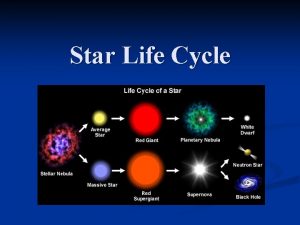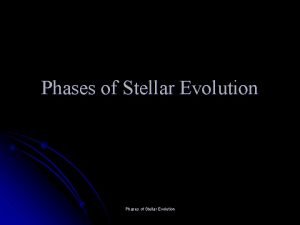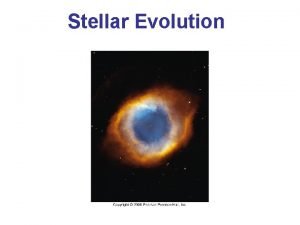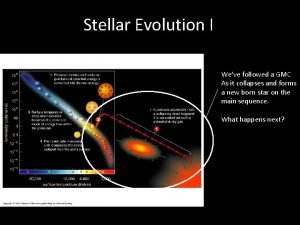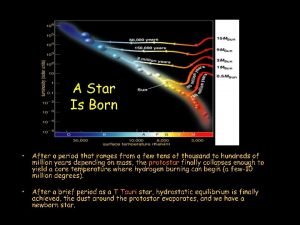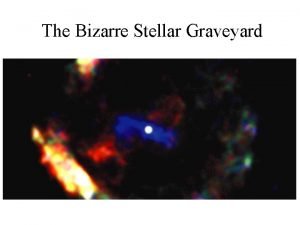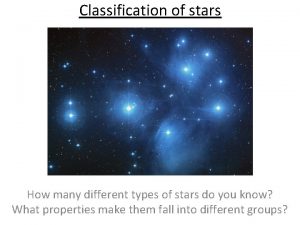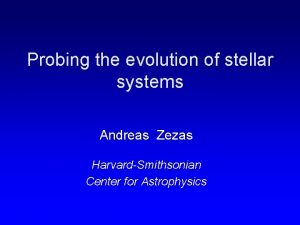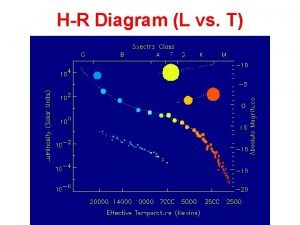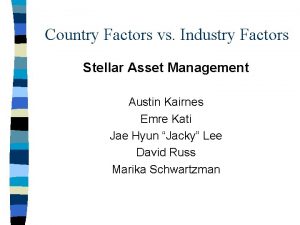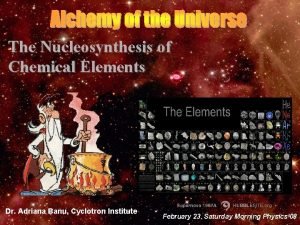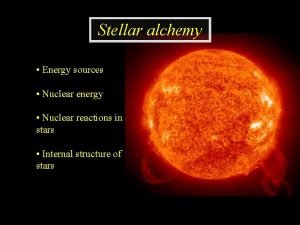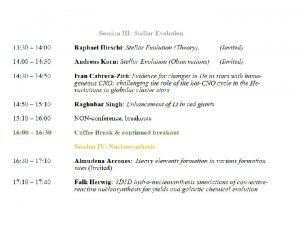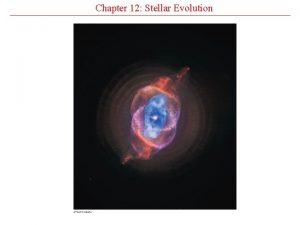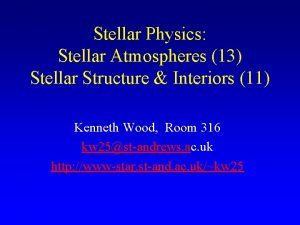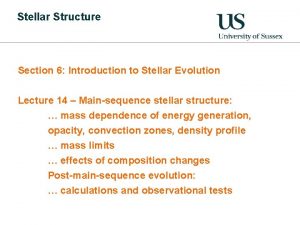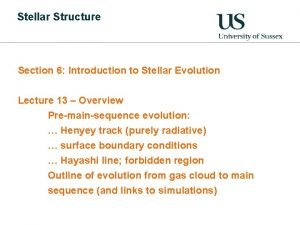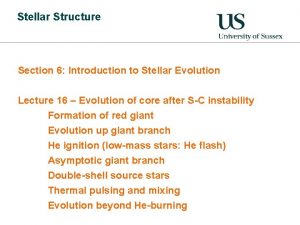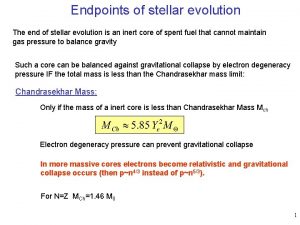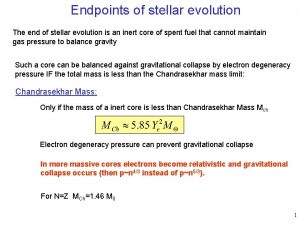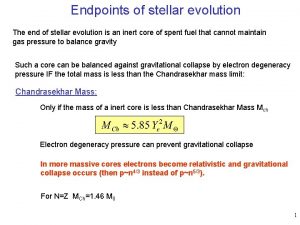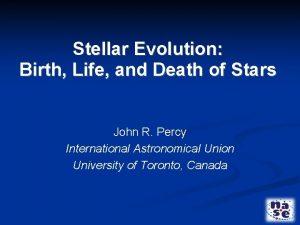Stellar Processes and Stellar Evolution The death of














































- Slides: 46

Stellar Processes and Stellar Evolution

The death of Stars At the end of a star’s lifetime as a main sequence star all the H in its core has been used up. How long this takes and a star’s ultimate fate depends upon its initial mass. Our sun will convert H into He for 5 x 109 years but a star of mass 25 M will take only about 106 years to use up all its H.

Chandrasekhar limit The electron pressure can stop the further collapse of the core and the star will become a stable white dwarf only if the mass of the core is less than 1. 4 M This is known as the Chandrasekhar limit. If the mass of the core is more than 1. 4 solar masses, the star will become a neutron star or a black hole. Subrahmanyan Chandrasekhar

The fate of stars The fate of a star depends on its initial mass. So, if: M < 8 M White dwarf ejecting 60% of its mass as a planetary nebulae However, if: 4 M < 8 M The star is able to fuse Carbon and in this process produce Neon, Sodium, Magnesium and Oxygen during their final red giant phase


Birth and death of stars Protostar formed from interstellar dust and gas Main sequence less than 4 M Main sequence between 4 M and 8 M Main sequence 8 M or greater Red Giant carbonoxygen core Super red giant iron core Planetary nebulae and white dwarf Supernova Neutron Star

Neutron stars and pulsars It is thought that a neutron star is the result of a supernova In such a star it is now degeneracy that which stops further contraction. Such star would have a density of 4 x 1017 kg/m 3 (a neutron star is so dense that one teaspoon - 5 m. L - of its material would have a mass over 5× 1012 kg) Rotating neutron stars emit electromagnetic waves (in the radio part of the spectrum and also X-rays) and are called pulsares.

Neutron stars and pulsars A pulsar has been found in the centre of Crab Nebulae (supernovae remnant) emitting a visible light pulse.

Black Holes A black hole is a region of space in which the gravitational field is so powerful that nothing can escape after having fallen past the event horizon. The name comes from the fact that even electromagnetic radiation is unable to escape, rendering the interior invisible. However, black holes can be detected if they interact with matter outside the event horizon, for example by drawing in gas from an orbiting star. The gas spirals inward, heating up to very high temperatures and emitting large amounts of radiation in the process.

Black Holes The point near the black hole where the escape velocity equals the speed of light is know as event horizon (or Schwarzschild radius): nothing can be seen beyond this point. When a dying star contracts within its event horizon the entire mass of the star will shrink to a mathematical point at which its density will be infinite. Such point is known as singularity. A black hole therefore consists of an event horizon and a singularity.

Hubble’s Law Distant galaxies are moving away from the Earth with a speed that is proportional to their distance Where d is the distance to the galaxy and v is its recession speed. H is known as Hubble’s constant and its average value is 65 km s-1 Mpc-1 • Distant galaxies are moving away from the Earth with a speed that is proportional to their distance

Galactic motion Galaxies are grouped into clusters which in turn are grouped into super-clusters. Due to the expansion of the Universe, the light received from galaxies is red-shifted. The shift in a spectral line from a galaxy emission spectrum is given by: The speed of the galaxy is given by: λ is the emitted (or rest) wavelength

Quasars A Quasar (contraction of QUASi-stell. AR radio source) is an extremely bright (10 000 x the Milky Way’s luminosity) and distant active galactic nucleus. They were first identified as being high redshift sources of electromagnetic energy, including radio waves and visible light that were point-like, similar to stars, rather than extended sources similar to galaxies. While there was initially some controversy over the nature of these objects, there is now a scientific consensus that a quasar is a compact halo of matter surrounding the central supermassive black hole of a young galaxy. Some quasars are as far as 4700 Mpc which make them the most distant objects. Red shift shows recession speeds of 0. 15 c to 0. 91 c!!

Stop Here Older/extra material follows

After the Big Bang In the first 10 -43 s after the Big Bang the four fundamental interactions (gravity, weak force, electromagnetic force and strong force) were unified At 10 -43 s (T=1032 K) gravity appeared a separated force. At 10 -35 s (T=1027 K) strong nuclear interaction separated from weak and electromagnetic interaction. Between 10 -35 s and 10 -24 s the Universe underwent a rapid expansion increasing its size by a factor of 1050 (Inflationary Epoch). Matter outnumbers anti-matter. At 10 -12 s (T=1012 K) the electromagnetic interaction separated from the weak interaction.

After the Big Bang At 10 -6 s temperature has dropped enough for individual protons and neutrons to exist At about 2 s (T=1010 K) neutrinos ceased to interact with protons and neutrons and By 3 minutes after the BB all the primordial He had been produced After some 300 000 years the Universe temperature had cooled enough for H and He atoms to exist. High energy photons no longer interact with atoms. The Universe became transparent to photons and it is these photons which now give rise to the 3 K background radiation



Measuring Astronomical Distances (summary Distance Method up to 100 pc Parallax and Cepheid variables and spectroscopic parallax up to 10 Mpc Cepheid variables and spectroscopic parallax up to 60 Mpc Cepheid and spectroscopic parallax up to 250 Mpc Super red giants and super blue giants and supernovae up to 900 Mpc Globular clusters and supernovae Beyond 900 Mpc Supernovae


The fate of the Sun When all the H in the core has been used, no fusion processes will counteract the gravitational contraction so the core will now start contract. However there is sill some H in the outer layers. The core’s contraction will increase its temperature and release energy that will heat the outer layers. This makes the burning hydrogen extend further into the outer regions.

The fate of the Sun As the core contracts, the Sun as a hole expands. This causes the Sun’s surface temperature to drop and its luminosity to increase. The Sun will become a Red Giant: T=3500 K R=0. 5 AU L = 2000 L

The fate of the Sun The He created by H burning in the outer layers adds to the mass of the core causing the core to further contract. Its T will rise enough for the He fusion to take place. He fusion will produce 12 C and 16 O. When all He has been used up the core further contracts. Its T rises and the energy radiated causes He burning in the outer layers: 2 nd red giant phase In this phase the Sun will engulf the Earth. Its luminosity will be 10 000 L

The fate of the Sun In this 2 nd red giant phase the Sun undergoes bursts of luminosity in which a shell of its outer layers is ejected into space. In this process the core will be exposed. Because of its surface temperature (100 000 K) the energy emitted will ionize the outer gas layers causing them to emit visible radiation producing a planetary nebula. The radius of the core is about that of the Earth and with no fusion reaction taking place within the core it will just simply cool down. The Sun has become a white dwarf star. Eventually it will radiate all its energy and become a black dwarf.

Outer layers White dwarf will eventually cool down Ring Nebula

The fate of the Sun Projected timeline of the Sun's life (from wikipedia)

The fate of the Sun http: //janus. astro. umd. edu/astro/stars/Suns. Life. html

The fate of the Sun The core of the Sun as a white dwarf does not keep contracting since there is a high density limit set by a quantum mechanical effect called electron degeneracy. This is the point where electrons cannot be packed any closer. Image of Sirius A and Sirius B taken by the HST. Sirius B, which is a white dwarf, can be seen as a faint dot to the lower left of the much brighter Sirius A.

The formation of Stars have their origin in nebulae, like Orion dark nebula.

The formation of Stars A typical dark nebula has a temperature of about 100 K and contains 1010 to 1019 particles. These consist of H (75%), He (24%) and dust (1%). The dust consists of atoms and molecules of many different elements. The density is big enough for gravity to pull the individual particles together. As the particles move together under their mutual gravitational attraction they loose gravitational energy and gain kinetic energy. The temperature will increase, ionisation of the molecules will take place and the system will acquire its own luminosity.

The formation of Stars At this point the so-called protostar is still very large and might have a surface temperature of 3000 K and therefore has considerable luminosity. A protostar of mass equal to the Sun can have a surface area 5000 x greater than the Sun and be 100 x as luminous. Potential solar system

The formation of Stars As the gravitational contraction continues the temperature of the core of the protostar continues to rise until it is at a sufficiently high temperature for all the electrons to be stripped from the atoms making up the core. The core has now become plasma and nuclear fusion takes place in which H is converted into He and the protostar becomes a main sequence star on the H-R diagram. The nuclear fusion process will eventually stop any further gravitational contraction and the star will have reached hydrostatic equilibrium in which gravitational pressure is balanced by the pressure created by the nuclear fusion processes.

The formation of Stars

The formation of Stars Whereabouts a protostar “lands” on the main sequence is determined by its initial mass. The greater the initial mass, the higher will be the final surface temperature and the greater will be its luminosity.

The formation of Stars The more massive a protostar (> 4 M ) the more quickly its core will reach a temperature at which fusion takes place: Protostars of mass 15 M 104 years Protostars of mass 1 M 107 years A massive protostar will have its luminosity quickly stabilised but temperature increases as it further contracts. For small protostars because the energy is lost by convection and not radiation, the surface temperature remains constant. The luminosity therefore will decrease as the protostar contracts.

The formation of Stars More massive stars take less time to reach the main sequence than less massive stars.

The formation of Stars Gravitational collapse puts a lower and a upper limit on the mass of matter that can form a star: Protostars of mass less than 0. 08 M Not enough temperature and pressure to initiate nuclear fusion and the protostar will contract to a brown dwarf. Protostars of mass more than 100 M Internal pressure overcomes gravitational pressure and vast amounts of matter will be ejected from the outer layer of the protostar thereby disrupting the evolution of the star.

Summary Core H all burnt Core contracts and T rises Outer layer H burning Luminosity increases RED GIANT Helium in core used up Further contraction of core and expansion of outer layers Ejection of mass via planetary nebulae He adds to the core WHITE DWARF Expansion of outer layer Core contracts He burning in core He burning in outer layers

The fate of stars with M > 8 M Stars with a mass of 8 M or more able to fuse even more elements than carbon. After all the C in the core has been used the core undergoes a further contraction and its T rises o some 109 K. Neon is produced by the fusion of carbon. When all Neon has been fused the core contracts again until it reaches a temperature at which Oxygen can be fused. Between each period of thermonuclear fusion in the core is a period of shell burning in the outer layers and the star enter a new red giant phase.

The fate of stars with M > 8 M When only shell burning is taking place the radius and luminosity of the star increases such that the result is a supergiant with a luminosity and radius much greater than that of a lower mass red giant.

The fate of stars with M > 8 M Eventually a temperature is reached in the core of a supergiant at which the fusion of silicon can take place. The product of burning silicone is iron. As seen in Nuclear Physics topic, elements with an atomic number of 26 or greater cannot undergo fusion (because of a large coulomb repulsion). As the fusion within the core cease, the star reaches a critical state. The entire inner core contracts very rapidly and reaches a very high T (≈6 x 109 K)

The fate of stars with M > 8 M The high energy gamma photons emitted collide with the iron nuclei breaking it into alpha-particles The core becomes very dense and electrons combine with protons producing neutrons and a vast flux of neutrinos As these carry a large amount of energy, the core cools and contracts. The rapid contraction produces an outward moving pressure wave. Because some material from the shells is collapsing, a colossal shock wave will be formed and it will rip the material of the star’s outer layers apart.

The fate of stars with M > 8 M The inner cores are now exposed and a vast amount of radiation floods out into space. The star has become a supernova. The star releases about 1046 J of energy and 96% of its mass. This energy is enough to produce elements with atomic numbers higher than iron.

The fate of stars with M > 8 M The material that is flung out in to space will eventually form dark nebulae from which new stars may be formed. And so the process repeats itself! “For you are dust, And to dust you shall return. " Genesis 3, 19

Galaxies A galaxy is a collection of a very large number of stars mutually attracting each other through the gravitational force and staying together. The number of stars varies between a few million and hundreds of billions. There approximately 100 billion galaxies in the observable universe. There are three types of galaxies: - Spiral (Milky Way) - Elliptical (M 49) - Irregular (Magellanic Clouds)

Galaxies Spirals / barred spirals Ellipticals Irregulars Flattened disc, central bulge from which spiral arms start. In barred galaxies, arms start from the ends of the bar. Halo. Spherical or ellipsoidal in shape with stars fairly uniformly distributed in the galaxy. No obvious structure. Star content The disc contains both young and old stars. Halo has mainly old stars. Contain both young and old stars. Gas and dust The disc contains significant amounts of both. The halo does not. Contain little or no gas and dust. Contain a lot of gas and dust. Shape Star No significant new star Very significant formation Takes place in spiral arms. formation in the last 10 billion years. star formation.
 Stages of stellar evolution of a low-mass star
Stages of stellar evolution of a low-mass star Stellar evolution diagram
Stellar evolution diagram Flowchart of the life cycle of a star
Flowchart of the life cycle of a star Stellar evolution
Stellar evolution Stellar evolution
Stellar evolution Stellar evolution
Stellar evolution Stellar evolution diagram
Stellar evolution diagram 17-4 patterns of evolution answer key
17-4 patterns of evolution answer key Lesson 17 patterns and processes of evolution
Lesson 17 patterns and processes of evolution Lesson 17 patterns and processes of evolution
Lesson 17 patterns and processes of evolution Concurrent processes are processes that
Concurrent processes are processes that How do geological processes affect evolution
How do geological processes affect evolution Somatic death vs molecular death
Somatic death vs molecular death Atmospheric heaven
Atmospheric heaven Stellar flux
Stellar flux Stellar motion matlab
Stellar motion matlab Virgo stellar
Virgo stellar Masses in the stellar graveyard
Masses in the stellar graveyard Stellar hosting iptv
Stellar hosting iptv Stellar assessment
Stellar assessment Stellar saga
Stellar saga What is stellar parallax?
What is stellar parallax? Stellar
Stellar Stellar formation
Stellar formation Stellar asset management
Stellar asset management Becquerel
Becquerel Stellar wifi
Stellar wifi Stellar alchemy
Stellar alchemy Hình ảnh bộ gõ cơ thể búng tay
Hình ảnh bộ gõ cơ thể búng tay Frameset trong html5
Frameset trong html5 Bổ thể
Bổ thể Tỉ lệ cơ thể trẻ em
Tỉ lệ cơ thể trẻ em Voi kéo gỗ như thế nào
Voi kéo gỗ như thế nào Chụp tư thế worms-breton
Chụp tư thế worms-breton Hát lên người ơi
Hát lên người ơi Các môn thể thao bắt đầu bằng tiếng đua
Các môn thể thao bắt đầu bằng tiếng đua Thế nào là hệ số cao nhất
Thế nào là hệ số cao nhất Các châu lục và đại dương trên thế giới
Các châu lục và đại dương trên thế giới Công thức tiính động năng
Công thức tiính động năng Trời xanh đây là của chúng ta thể thơ
Trời xanh đây là của chúng ta thể thơ Cách giải mật thư tọa độ
Cách giải mật thư tọa độ Làm thế nào để 102-1=99
Làm thế nào để 102-1=99 độ dài liên kết
độ dài liên kết Các châu lục và đại dương trên thế giới
Các châu lục và đại dương trên thế giới Thể thơ truyền thống
Thể thơ truyền thống Quá trình desamine hóa có thể tạo ra
Quá trình desamine hóa có thể tạo ra Một số thể thơ truyền thống
Một số thể thơ truyền thống
